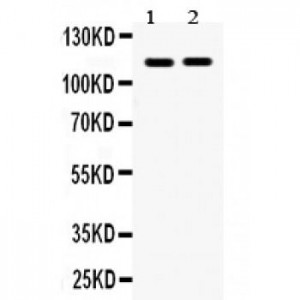More info
Overview
Long Name | Antibody Type | Antibody Isotype | Host | Species Reactivity | Validated Applications | Purification |
| EPH receptor A5 | Polyclonal | IgG | Rabbit | Human, Mouse, Rat | WB | Immunogen affinity purified. |
Immunogen | ||||||
| A synthetic peptide corresponding to a sequence at the C-terminus of human Eph receptor A5 (1001-1032aa TLEDLRRLGVTLVGHQKKIMNSLQEMKVQLVN), different from the related mouse sequence by two amino acids. | ||||||
Properties
Form | Lyophilized |
Size | 100 µg/vial |
Contents | Antibody is lyophilized with 5 mg BSA, 0.9 mg NaCl, 0.2 mg Na2HPO4, 0.05 mg NaN3. *carrier free antibody available upon request. |
Concentration | Reconstitute with 0.2 mL sterile dH2O (500 µg/ml final concentration). |
Storage | At -20 °C for 12 months, as supplied. Store reconstituted antibody at 2-8 °C for one month. For long-term storage, aliquot and store at -20 °C. Avoid repeated freezing and thawing. |
Additional Information Regarding the Antigen
Gene | EPHA5 |
Protein | Ephrin type-A receptor 5 |
Uniprot ID | P54756 |
Function | Receptor tyrosine kinase which binds promiscuously GPI- anchored ephrin-A family ligands residing on adjacent cells, leading to contact-dependent bidirectional signaling into neighboring cells. The signaling pathway downstream of the receptor is referred to as forward signaling while the signaling pathway downstream of the ephrin ligand is referred to as reverse signaling. Among GPI-anchored ephrin-A ligands, EFNA5 most probably constitutes the cognate/functional ligand for EPHA5. Functions as an axon guidance molecule during development and may be involved in the development of the retinotectal, entorhino- hippocampal and hippocamposeptal pathways. Together with EFNA5 plays also a role in synaptic plasticity in adult brain through regulation of synaptogenesis. In addition to its function in the nervous system, the interaction of EPHA5 with EFNA5 mediates communication between pancreatic islet cells to regulate glucose- stimulated insulin secretion (By similarity). |
Tissue Specificity | Almost exclusively expressed in the nervous system in cortical neurons, cerebellar Purkinje cells and pyramidal neurons within the cortex and hippocampus. Display an increasing gradient of expression from the forebrain to hindbrain and spinal cord. |
Sub-cellular localization | Cell membrane ; Single-pass type I membrane protein . Cell projection, axon . Cell projection, dendrite. |
Sequence Similarities | Belongs to the protein kinase superfamily. Tyr protein kinase family. Ephrin receptor subfamily. |
Aliases | Brain-specific kinase antibody|bsk antibody|CEK 7 antibody|Eck like sequence 1 antibody|EHK 1 antibody|EHK-1 antibody|EK7 antibody|Els 1 antibody|Eph homology kinase 1 antibody|EPH-like kinase 7 antibody|EphA5 antibody|EPHA5_HUMAN antibody|Ephrin type A receptor 5 antibody|Ephrin type-A receptor 5 antibody|HEK 7 antibody|hEK7 antibody|Receptor protein tyrosine kinase HEK 7 antibody|Rek 7 antibody| TYRO 4 antibody|TYRO 4 antibody|Tyrosine protein kinase receptor EHK 1 antibody |
Application Details
| Application | Concentration* | Species | Validated Using** |
| Western blot | 0.1-0.5μg/ml | Mouse, Rat Human | AssaySolutio's ECL kit |
AssaySolution recommends Rabbit Chemiluminescent WB Detection Kit (AKIT001B) for Western blot. *Blocking peptide can be purchased at $65. Contact us for more information

Anti- Eph receptor A5 antibody, ASA-B0657, Western blotting
All lanes: Anti Eph receptor A5 (ASA-B0657) at 0.5ug/ml
Lane 1: Rat Brain Tissue Lysate at 50ug
Lane 2: Mouse Brain Tissue Lysate at 50ug
Predicted bind size: 114KD
Observed bind size: 114KD
All lanes: Anti Eph receptor A5 (ASA-B0657) at 0.5ug/ml
Lane 1: Rat Brain Tissue Lysate at 50ug
Lane 2: Mouse Brain Tissue Lysate at 50ug
Predicted bind size: 114KD
Observed bind size: 114KD



